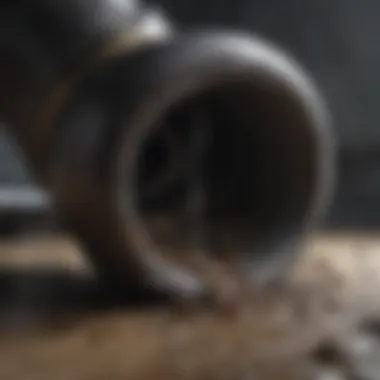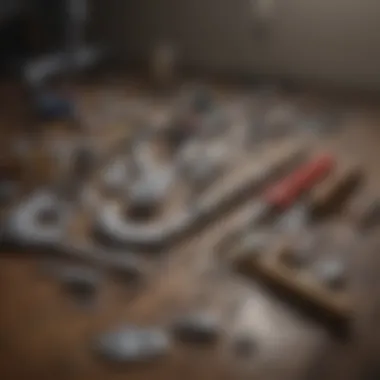Unlocking the Secrets to Unclogging Drain Pipes


Intro
Clogged drain pipes are a prevalent issue in many households. They can lead to water backing up, unpleasant odors, and even severe damage if not addressed timely. Understanding how to efficiently handle this problem can save you both time and money. This guide aims to provide a thorough overview of various methods to unclog drain pipes, including household remedies and more professional techniques.
Residents often overlook the significance of maintaining clear drainage systems. An occasional blockage might seem benign; however, it can lead to more significant complications if not resolved. Therefore, it is essential to equip yourself with effective solutions. In this guide, the focus will be on practical approaches that are accessible for all homeowners, regardless of their level of experience.
We will explore different strategies to clear pipes. This includes the use of common household items, tools you might need, as well as when to consider engaging a plumber for persistent issues. Recognizing the signs of a clogged pipe and determining the right method to apply are crucial aspects that will be discussed.
By the end of this article, you will not only have a comprehensive understanding of how to tackle clogged drains, but you will also feel confident in your ability to keep your pipes flowing freely.
Understanding Drain Clogs
In every household, drain clogs are a common yet frustrating issue. Understanding the nature of drain clogs is crucial. Knowledge of how they occur helps in preventing and addressing them effectively. This section provides a foundation for comprehending the issue at hand, thereby enabling a strategic approach toward unclogging methods.
Identifying the causes of clogs, knowing the types of drain systems, and recognizing early signs can save both time and money. Understanding drain clogs enables individuals to decide on either DIY methods or when it is time to contact a professional.
Common Causes of Clogs
Clogs can form due to multiple factors. Most commonly, hair, grease, soap residue, and food particles play a significant role. Hair accumulates in bathroom drains, while grease typically collects in kitchen sinks. Another factor is the build-up of soap residue which can occur in various drains. Food particles often contribute to clogs especially in kitchen sinks.
Additionally, tree roots and foreign objects can obstruct pipelines, causing unexpected clogs. Regular maintenance and awareness of what goes down the drain can minimize these issues.
Types of Drain Systems
Understanding the types of drain systems is essential for knowing how to manage and unclog them effectively. Here, we will explore both residential and commercial drain systems, as each has unique characteristics and implications.
Residential Drain Systems
Residential drain systems are designed for homes and typically involve a network of pipes that carry wastewater away from sinks, showers, and toilets. The key characteristic of residential systems is their relatively simplified structure. This simplicity often leads homeowners to underestimate the importance of maintenance.
A beneficial aspect of residential drain systems is their accessibility; many homeowners can perform basic unclogging methods themselves. However, a unique feature is the vulnerability to clogs due to accumulation of hair and grease. These factors can lead to frequent maintenance needs.
Advantages of these systems include cost-effectiveness and a variety of DIY solutions. Nonetheless, they can suffer from serious issues if not maintained regularly, leading to costly repairs.
Commercial Drain Systems
Commercial drain systems are more complex and are designed to handle significantly larger volumes of wastewater. These systems are crucial for restaurants, hotels, and other commercial establishments. A key characteristic of commercial systems is their robust design, which often includes multiple lines and larger pipes.
This complexity allows for efficient waste management, but it can pose challenges during blockages. The systems might require specialized equipment or professional services to clear congestion.
The unique feature of commercial drain systems is their capacity to service numerous fixtures simultaneously. This can lead to a variety of clogs that may arise from high use. One advantage is that such systems tend to be engineered to prevent frequent clogs. However, if a clog does occur, the repercussions can be more severe, often requiring immediate professional attention to avoid business interruptions.
Understanding these differences is key so that homeowners and business owners alike can manage their drain systems more effectively.
Identifying the Location of the Clog
Identifying the location of the clog is a crucial step in managing a drainage issue. Knowing where the blockage is situated allows for targeted action. By understanding the symptoms, homeowners can avoid guesswork and better utilize their resources. Ignoring this aspect could lead to ineffective attempts at unclogging and, ultimately, more extensive repairs. The goal is to first pinpoint the clog before diving into specific remedies, ensuring that attempts are both efficient and effective.
Signs of a Clogged Drain
Recognizing the signs of a clogged drain can save valuable time and effort. By being observant, one can take action earlier to prevent a more severe blockage.
Slow Drainage
Slow drainage is often the first indicator of a problem. Water that does not drain promptly suggests that there is an obstruction in the pipe. This situation could arise from a buildup of hair, soap scum, or food debris. The key characteristic of slow drainage is its gradual onset. It is beneficial in that homeowners can take preventive measures before a complete blockage occurs. However, if left unchecked, slow drainage will escalate into more significant issues. This makes it a unique marker for early intervention in this article.


Unpleasant Odors
Unpleasant odors coming from drains are another telltale sign of clogs. These smells are often due to trapped debris decomposing within the pipe. The key characteristic of this issue is its ability to make the environment less pleasant. Recognizing these odors is critical since they signal a developing situation that requires action. There are both advantages and disadvantages to this sign; while it alerts homeowners to potential problems, it can also be an indicator of more serious plumbing issues if the odors persist. This aspect is essential in the context of maintaining a clean home environment.
Gurgling Sounds
Gurgling sounds emanating from the drain can be unsettling. This noise typically indicates air trying to escape through a blockage in the pipe. The unique feature of gurgling sounds is that they often signal an obstruction is already in place, rather than a slow buildup. Therefore, gurgling serves as an early alert that something needs to be addressed. Recognizing these sounds can prevent a minor issue from becoming an emergency situation. Like other signs, it provides crucial insight into the condition of the drain and informs the approach one should take in addressing the problem.
Diagnostic Techniques
Once the signs are noted, applying diagnostic techniques can help ascertain the extent and location of the clog.
Using a Plunger
Using a plunger is a traditional and effective method for dealing with clogs. The action of the plunger creates pressure that can dislodge minor blockages. A key characteristic of this tool is its simplicity and accessibility. The benefits lie in its ease of use; virtually anyone can operate a plunger with basic instructions. However, this method may not be effective for deeper clogs in larger pipes. Thus, understanding its limitations is essential to avoid frustration.
Inspecting with a Snake Camera
Inspecting with a snake camera is a more modern approach for diagnosing drain clogs. This tool allows for visual inspection inside the pipes. The sleek, flexible design of these cameras provides a comprehensive view of the internal condition of the plumbing system. The key characteristic of the snake camera is its ability to identify the nature and extent of the clog. This can be particularly beneficial for resolving recurring issues. Nonetheless, the use of a snake camera may require technical expertise and often comes with a cost. This method offers significant advantages for detailed diagnostics, especially in complex plumbing systems.
Preparation for Unclogging
Preparation is a critical step when it comes to unclogging drains. Proper preparation not only makes the process more efficient but also significantly reduces the likelihood of accidents or damage to plumbing systems. Understanding the tools and materials needed is essential. Additionally, prioritizing personal safety through appropriate precautions is important to protect yourself from potential hazards during the unclogging process.
Being prepared creates an organized approach, allowing for a methodical unclogging process. Before initiating any method in this guide, taking the time to assess the situation can lead to a more effective resolution.
Required Tools and Materials
Plunger
The plunger is one of the most common tools for unclogging drains. Its main function is to create pressure that can force a clog through the plumbing system. The key characteristic of a plunger is its suction cup base, which allows for effective sealing against the drain. This makes it a popular option as it is often the first tool many will reach for when faced with a clog.
A significant benefit is its accessibility. Most households possess a plunger, making it a convenient choice. However, a potential disadvantage is that its effectiveness can vary depending on the type of clog and the condition of the drain.
Drain Snake
A drain snake, also known as a plumbing snake, is another valuable tool for dealing with stubborn clogs. This tool is designed to reach deep into the pipes, where more resilient blockages may exist. The key characteristic of a drain snake is its long, flexible metal wire that can navigate bends in pipes.
The effectiveness of a drain snake lies in its ability to break through larger clogs or grab obstructions that a plunger cannot. However, its use requires careful handling; improper use can cause damage to pipes, making it a unique tool that requires some skill and caution.
Baking Soda and Vinegar
Baking soda and vinegar present a more natural alternative to chemical solutions. This combination works on the principle of a chemical reaction that can help to dislodge minor clogs. The key characteristic of this method is its use of non-toxic materials, which is appealing for those concerned about environmental impact.
Baking soda and vinegar create a bubbling action that can clear out small blockages. The advantages include safety for plumbing and the environment. However, its limitations become apparent with tougher clogs or deep blockages, where traditional tools may perform better.
Safety Precautions
Wearing Gloves
Wearing gloves is a fundamental safety measure during the unclogging process. The key characteristic of gloves is their protective barrier against grime, sharp objects, and harmful bacteria often found in drains. They are a beneficial choice in maintaining hygiene while handling tools and materials.
Moreover, gloves protect your skin from potential irritants, or chemicals, that may be involved. However, they can sometimes limit dexterity, which is something to consider when using tools like a drain snake.
Using Eye Protection
Using eye protection is another necessary precaution. Protection for the eyes is crucial, as splashes from water, debris, or even chemical solutions pose a risk of injury. The key characteristic of proper eye protection is its ability to shield against unexpected particles or liquids.


It enhances safety by allowing you to focus on the task without worrying about possible damage to your eyes. However, the drawback is that wearing protective eyewear may feel cumbersome for some while working in tight spaces.
DIY Methods for Unclogging Drains
Learning how to address clogged drains using do-it-yourself methods is valuable for homeowners. It empowers you to solve common issues without always relying on professionals. These methods often use everyday materials, making them cost-effective and accessible. Since clogged drains can lead to inconveniences like slow drainage or persistent odors, knowing how to handle them is essential for home maintenance.
Using a Plunger
A plunger is a fundamental tool for clearing clogs. It works by creating a vacuum seal, which when forcefully moved, can dislodge obstructions. For best results:
- Ensure a good seal: Submerge the plunger in water, covering the drain completely.
- Use quick, forceful thrusts: Alternate between pressing down and pulling up.
- Repeat as necessary: A few tries might be needed, especially for stubborn clogs.
It is useful to note that plungers are most effective for solid obstructions near the drain's entrance, such as hair or food scraps.
Baking Soda and Vinegar Solution
A mixture of baking soda and vinegar serves as a natural alternative to harsh chemicals. This method utilizes the reaction between these two substances to break down clogs. To use this technique:
- Pour one cup of baking soda into the drain.
- Add one cup of vinegar, and quickly cover the drain to contain the reaction.
- Let it sit for about 30 minutes, then flush with hot water.
This method is effective for organic material and mild soap buildups. Baking soda can neutralize odors, while vinegar helps dissolve debris.
Boiling Water Technique
Boiling water is a simple yet effective unclogging method. It is most useful for grease buildups. To apply this technique:
- Boil a kettle of water.
- Slowly pour the boiling water down the affected drain in two to three stages.
- Wait a few minutes in between each pour.
This method is quick and utilizes the heat to dissolve grease and soap residues, making it a straightforward solution for minor clogs.
Employing a Drain Snake
A drain snake is a versatile tool designed to reach deep into pipes and remove clogs. Here's how to effectively use it:
- Insert the snake into the drain and push until you feel resistance.
- Rotate the handle to help break up the clog.
- Pull out the snake slowly, bringing any debris with it.
A drain snake can navigate bends in pipes where a plunger may not reach. It is particularly effective for clogs caused by hair or solid waste.
DIY methods for unclogging drains can save money and time. Mastering these techniques provides homeowners with the means to maintain their plumbing.
Chemical Drain Cleaners
Chemical drain cleaners play a significant role in resolving stubborn clogs. These products are designed to penetrate blockages, breaking down the debris causing the drain issue. The importance of using chemical drain cleaners lies in their effectiveness under certain circumstances. They often present a quick solution to immediate problems, especially when other methods have not yielded results. However, they must be used with caution.
The next sections delve into different types of chemical cleaners, their characteristics, and their potential advantages and disadvantages.
Types of Chemical Cleaners
Liquid Drain Cleaners
Liquid drain cleaners are one of the most common types found in households. They typically contain strong chemicals that dissolve organic matter clogging the pipes. The key characteristic of liquid drain cleaners is their ability to work quickly. Most products claim results within minutes. This makes them a popular choice for people seeking immediate relief from clogged drains.
One unique feature of liquid drain cleaners is their formulation, which often includes lye or sulfuric acid. These ingredients are very effective in breaking down grease, hair, and soap scum, three common culprits of drain clogs. However, despite their efficiency, they come with disadvantages. They can be harmful to pipes, especially older ones, and pose risks to personal safety. Care must be taken to read the instructions and wear appropriate personal protective equipment.
Granular Drain Cleaners
Granular drain cleaners offer an alternative to liquid formulas. They come in powder form and usually contain active ingredients similar to those in liquid cleaners. The key characteristic of granular drain cleaners is their versatility. They can be poured directly into the drain, where they react with water to create heat, which helps dissolve blockages.


One unique aspect of granular cleaners is their capacity for prolonged action. Unlike some liquid cleaners that work quickly and are often washed away, granular options can remain in the pipe longer, continuing to break down blockages effectively. This provides a more sustained solution in certain cases. However, granular cleaners may require more time to yield results compared to their liquid counterparts.
Effectiveness and Risks
When considering chemical drain cleaners, effectiveness and risks must be evaluated. On one hand, these products can be very effective at removing clogs, especially when the blockage is mainly organic material. On the other hand, there are inherent risks. Chemical exposure can lead to severe burns or respiratory issues if appropriate safety measures are neglected. Furthermore, repeated use of chemical cleaners can lead to pipe damage, resulting in more significant issues over time.
Seeking Professional Help
When dealing with a blocked drain, knowing when to enlist a professional plumber is crucial. While some clogs can be resolved using DIY methods, others may require expert intervention. Attempting to fix a complex problem without the right knowledge can lead to more significant issues, including pipe damage and extensive repairs.
Professional plumbers have experience in identifying various types of clogs. They possess specialized tools such as hydro-jetters and inspection cameras, making it easier for them to locate and resolve the issue quickly. Moreover, they understand local plumbing codes and regulations, ensuring that any work they do complies with legal standards.
When to Call a Plumber
- Persistent Clogs: If you have tried multiple methods to unclog a drain with no success, it may be time to call a plumber. This is indicative of a more serious blockage that requires professional tools.
- Frequent Backups: Regularly dealing with clogs can signal underlying issues in your plumbing system. A plumber can perform a thorough examination and identify potential causes of repeated problems.
- Multiple Drains Affecting Each Other: If multiple drains in your home are backing up, it could indicate a problem in the main drainage line. This situation calls for a professional to assess the situation accurately and prevent further damage.
- Unpleasant Odors: Bad smells emanating from your drains can indicate sewage backing up or other hazardous conditions. A professional will ensure safe and effective resolution.
- Inexperienced Attempts: If you have used chemical drain cleaners without results, or if you feel unsure about the tools, consider hiring a professional. Their expertise will save you time and prevent additional damage.
Cost Considerations
The cost of hiring a professional plumber can vary significantly based on several factors. Understanding these elements can help you better prepare for expenses related to drain cleaning.
- Type of Service: Basic unclogging can be less costly, while extensive repairs due to pipe damage will increase expenses.
- Location: Plumbers in metropolitan areas often charge more than those in rural regions due to higher demand and living costs.
- Extent of Issue: The severity of the clog can affect the overall bill. Simple jobs are quick, while complex problems require more time and effort.
- Hourly Rates vs. Flat Fees: Some plumbers charge by the hour, whereas others may offer a flat fee for specific services. It’s important to clarify billing practices before hiring.
"Early intervention may save you not only money but also time and hassle in dealing with complex plumbing problems."
- Emergency Services: If a clog results in an emergency situation, such as sewage backup, expect higher costs for immediate service.
Evaluating these factors will allow you to make informed decisions regarding plumbing services. Remember, issues with drains are pivotal to the functionality of a home, and seeking professional help can ultimately enhance your property's value and comfort.
Preventing Future Clogs
Preventing future clogs in drain pipes is an essential aspect of maintaining a healthy household. It helps avoid the inconvenience, potential damage, and costs associated with recurring plumbing issues. Neglecting to proactively manage drainage systems can lead to larger problems down the line, including serious plumbing repairs and structural damage to ceilings and walls. Therefore, homeowners should implement strategies to mitigate obstructions in their drainage systems.
Regular Maintenance Practices
Implementing regular maintenance practices can significantly reduce the likelihood of clogs. Here are some effective strategies:
- Routine Cleaning: Regularly clean sink traps and strainers to remove hair, soap scum, and other debris that can accumulate and cause blockages. This simple step can save time and effort in the long run.
- Hot Water Flushes: Occasionally flush drains with hot water. This can help dissolve grease buildups that might lead to slow drainage over time. Doing this monthly can effectively keep the lines clear.
- Biological Drain Cleaners: Consider using biological drain cleaners. These products use enzymes and bacteria to slowly eat away organic material in the pipes. Their regular use can aid in prevention without harsh chemicals.
- Increased Awareness: Pay attention to warning signs, such as slow drainage or unusual noises. Early detection can lead to immediate responses, preventing more severe blockages.
Maintaining vigilance in these areas contributes greatly to the longevity and functionality of drain systems, ultimately saving individuals time and money.
Proper Disposal Techniques
Proper disposal techniques play a crucial role in preventing clogs. Many residents unknowingly contribute to their plumbing problems through improper waste disposal. Here are some key practices:
- Avoid Flushing Non-Degradable Items: Never flush items like paper towels, sanitary products, or wet wipes. These materials do not break down easily and can quickly cause clogs.
- Food Waste Management: Use composting for food scraps when possible. If a disposal unit is used, be mindful of putting fibrous foods like celery or potato peels down the drain, as they can wrap around blades and cause jamming.
- Mind your Grease: Do not pour grease down the sink. Once it cools, it solidifies and sticks to the pipe walls, creating an obstruction. Instead, collect grease in a container and dispose of it in the trash.
- Maintain a Clear Surrounding Area: Ensure that outdoor drains and gutters are not clogged with leaves and debris. This can help prevent water from backing up into the drainage system.
By incorporating good disposal habits and proper maintenance strategies, homeowners can significantly reduce the occurrence of blocked drains, contributing to a more efficient and effective plumbing system.
"Prevention is better than cure", particularly true when it comes to maintaining drain systems.
Culmination
In the context of managing clogged drains, a well-structured conclusion serves multiple purposes. It provides a summary of essential findings while also guiding the reader toward practical considerations. Understanding the methods discussed throughout the article is crucial for homeowners, renters, and property managers alike. The takeaway is that effective clog management not only saves time and money, but also prevents the escalation of plumbing issues.
Final Thoughts on Clog Management
Effective clog management hinges on a thorough understanding of the problem. Recognizing the early signs of a blockage can lead to quicker interventions. Homeowners should be proactive rather than reactive. Simple methods such as regular drain maintenance and proper disposal techniques can significantly decrease the chances of encountering major clogs in the future.
Proactive management of drainage systems can save unnecessary expenses and maintain property value.
Consider the types of materials routinely sent down the drain. Items like grease, hair, and food particles are leading culprits of drain clogs. Implementing habits that promote proper disposal can prevent these issues altogether.
Lastly, when complex blockages arise, knowing when to call a professional can alleviate stress. The cost of professional services may seem daunting, but it often becomes the most economical choice when faced with extensive plumbing problems. Through informed decisions and effective practices, managing clogged drains becomes a less arduous task. Whether you decide to employ DIY techniques or seek expert assistance, a clear understanding of the situation is your best asset.







